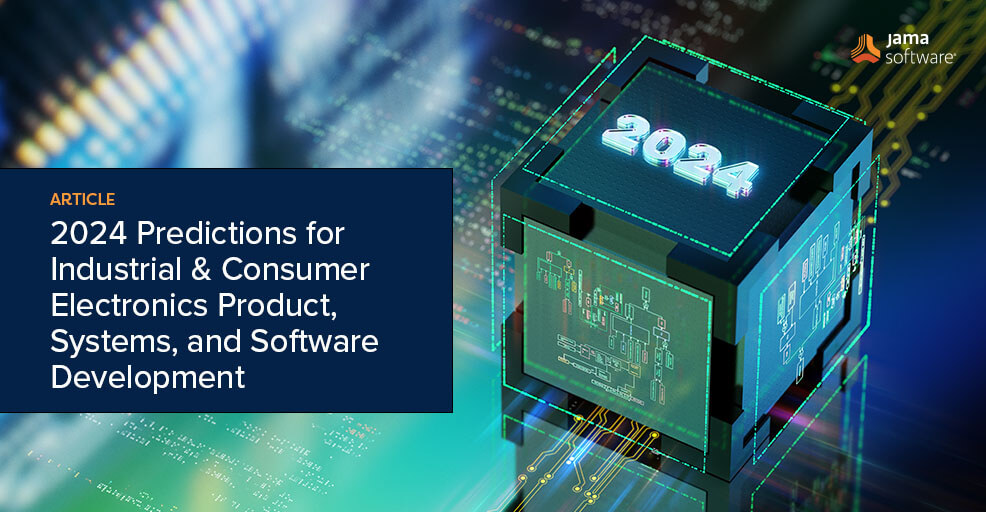2024 Predictions for Industrial and Consumer Electronics (ICE) Product Development
As the Industrial and Consumer Electronics (ICE) sector moves into 2024, we aim to gain a deeper insight into the factors driving transformation in the development of products, systems, and software and explore how teams within this sector are adapting to meet the challenges posed by these evolving complexities.
In part three of this six-part series, we asked our own industry expert Steven Meadows – Principal Solutions Lead at Jama Software®, to weigh in on the ICE product, systems, and software trends he’s anticipating in the coming year and beyond.
We like to stay on top of trends in other industries as well. Read our predictions for Automotive predictions HERE, Aerospace & Defense HERE, Medical Device & Life Sciences HERE, SoftTech HERE, and Product & Engineering Teams HERE.
Design Trends – What are the biggest trends you’re seeing in your industry right now? How will they impact ICE product development?
Steven Meadows: The Internet of Things (IoT) continues to remain at the forefront of development across consumer electronics manufacturing. ‘Smart’ products like home security systems, laptops, kitchen appliances, and tablets are manufactured with an increasing number of sensors and inputs that transfer data to different networks and applications. With more complex and integrated systems, the need for digital product development tools to ensure product quality is becoming increasingly important.
We’re seeing a shift in oil and gas companies managing requirements from documents to digital solutions. Increasingly complex projects that incorporate the setup of facilities and adherence to multiple standards have made this shift a priority.
Cloud computing, as we wrote about last year, continues to grow across the software industry. Cloud is the golden standard, allowing for more flexible, cheaper, and sustainable solutions. More and more companies increasingly rely on cloud computing for projects and daily activities without the need for managing system administration, upgrades, and security.
RELATED: Jama Connect® for Robotics Datasheet
Biggest Challenges – What are some of the biggest challenges you think ICE companies will be working to overcome in 2024?
Meadows: Artificial Intelligence (AI) has been at the forefront of development for years and continues to evolve, allowing for more automation, self-maintenance and diagnosis, and other areas which have improved end products.
One challenge I see for industrial and consumer electronics companies to remain competitive is incorporating AI in their products to help with less costly maintenance and production lines. AI-assisted firmware development will help with this.
Regulations – What changing regulatory guidelines do you anticipate having an impact on companies in 2024?
Meadows: I have attended several conferences this year across different industries and it’s safe to say that more regulatory guidelines around artificial intelligence will be released and impact companies in 2024. This will certainly have an influence on product development and what companies can include in their products. It will be interesting to see what guardrails the government and other entities will enforce.
Tool Innovation – From an ICE engineering toolset perspective, what are some of the processes you think forward-thinking firms will be working to leverage or incorporate into their process and why?
Meadows: We’re seeing several trends across industrial and consumer electronics development. Companies at different scales, from startups to large enterprises, are placing a greater emphasis on maturing effective internal development processes and tools.
Requirements authoring has often been challenging for teams with differing experiences. Poorly defined requirements often lead to poor products and systems, more defects in the field, and costly recalls. Companies are embracing AI and machine learning in their toolset to help teams author better-quality, less ambiguous, and easily testable requirements. By applying the industry’s best-known methods for evaluating and recommending improvements across requirement statements, including the Easy Approach to Requirement Syntax (EARS) and International Council on Systems Engineering (INCOSE) guidelines, companies are noticing significant improvements with products being shipped to customers.
Our customers continue to see the value in shifting their product development process, enabled through a document-centric process, to a modern digital solution. With Live Traceability™ – and all development artifacts housed in a single source of truth inside Jama Connect® – development teams benefit from a real-time view of related artifacts and development activities. This is enabling our customers to reduce risk early on, speed time to market, as well as improve product quality.
RELATED: IEC 61508 Overview: The Complete Guide for Functional Safety in Industrial Manufacturing
What advice would you give to new companies entering the ICE industry?
Meadows: Make sure you place an emphasis on solid product development processes and tooling early on, even at the prototype stage. Your ideas may be great but unless you have an effective development process defined early on with the right tools to enable it, your products will ultimately suffer, and you’re introducing unnecessary risk.
- FDA Issues Comprehensive Draft Guidance for Developers of Artificial Intelligence-Enabled Medical Devices - January 15, 2025
- 2025 Expert Predictions for Medical Device & Life Sciences: Innovations in Patient-Centered Care and the Future of Medical Device Design - January 9, 2025
- Jama Connect® Enables DevSecOps Through Robust API and Integrations That Connect All Activity to Requirements - January 7, 2025
